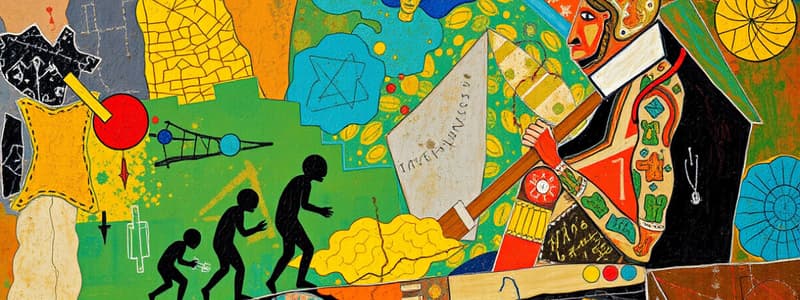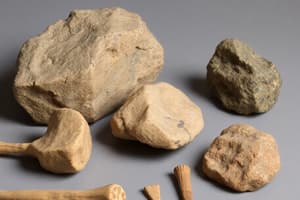Podcast
Questions and Answers
What defines the Oldowan toolkit in terms of its physical characteristics?
What defines the Oldowan toolkit in terms of its physical characteristics?
- It consists of hammer stones that display battering on their surfaces. (correct)
- It includes advanced flake-tools specifically designed for specialized cutting.
- It features bifacial handaxes as its primary tools.
- It produces tools with an average cutting edge of 12 inches from a pound of flint.
Which innovation was significant in the Middle Paleolithic for generating specialized stone tools?
Which innovation was significant in the Middle Paleolithic for generating specialized stone tools?
- The use of the pebble-tool traditions for weapon making.
- The development of bronze smelting.
- The adoption of agriculture for tool creation.
- The prepared core technique for flake production. (correct)
Which of the following is NOT a characteristic of the Acheulean toolkit?
Which of the following is NOT a characteristic of the Acheulean toolkit?
- The creation of simple tools sometimes indistinguishable from natural objects. (correct)
- The handaxes included within the toolkit.
- Tools produced with a cutting edge of 12 inches from a pound of flint.
- The integration of sophisticated hafting techniques for spear points.
What was a major cultural shift during the Neolithic Period?
What was a major cultural shift during the Neolithic Period?
What types of tools were primarily developed during the Middle Stone Age?
What types of tools were primarily developed during the Middle Stone Age?
Flashcards are hidden until you start studying
Study Notes
Overview of Pre-Historic Achievements in Science and Technology
- Man's scientific achievements are categorized into discovery and invention.
- Timeline spans from 3.4 million years ago, divided into three periods based on tool sophistication: Paleolithic, Mesolithic, and Neolithic.
Paleolithic Period (Early Stone Age)
- Four fundamental tool traditions established by Paleolithic ancestors:
- Pebble-tool traditions
- Bi-facial tool or hand-axed traditions
- Flake-tool traditions
- Blade-tool traditions
- Stone tools created from various materials such as flint and chert, intended for cutting, chopping, scraping, and sawing.
- Oldowan toolkit, attributed to Homo habilis, is the oldest known set of stone tools, identified by hammer stones with battering marks; first created around 3.4 million years ago.
- Acheulean toolkit characterized by larger, bifacial handaxes, producing 12 inches of cutting edge from one pound of flint, first discovered at St. Acheul in France.
- Middle Paleolithic innovation marked by the prepared core technique, allowing precise control over tool shape and size with a single blow.
Middle Stone Age Developments
- Toolkits included points for spears, stone awls for hide perforation, and scrapers.
- Innovations such as needles, thread, skin clothing, harpoons, spear throwers, and fishing equipment emerged.
Neolithic Period
- Defined by the transition to herding societies, bronze smelting, agriculture shift from gathering to producing, and pottery development.
- Marked increased complexity in living, leading to settled communities.
Bronze Age (3000 BC - 1200 BC)
- Second stage in the Stone-Bronze-Iron system, transitioning from Neolithic to increased tool sophistication.
- Initiated the mining and metallurgy era; first use of bronze from alloyed copper with tin or arsenic.
- Characterized by extensive metal use and trade development.
Iron Age (500 BC - 332 BC)
- Dominated by iron as the primary tool-making material, marking advanced production of tools and weaponry.
- Notable use of meteoric iron since 3200 BC.
- Iron significantly improved efficiency and productivity in daily life.
Fire: A Pivotal Discovery
- Fire stands out as the most critical discovery of the Paleolithic Era, greatly influencing human development and survival.
Studying That Suits You
Use AI to generate personalized quizzes and flashcards to suit your learning preferences.




